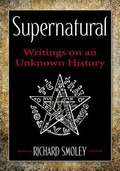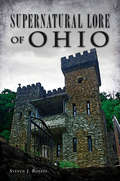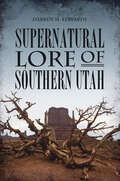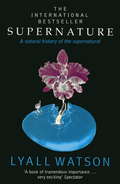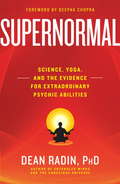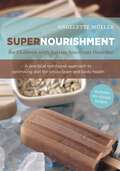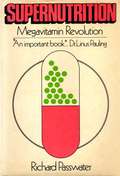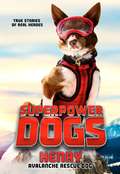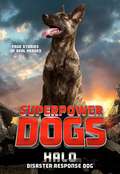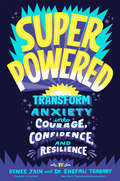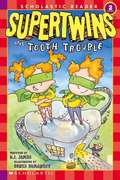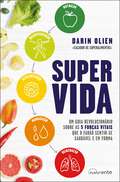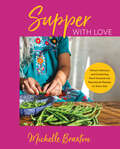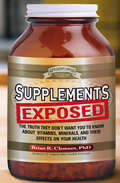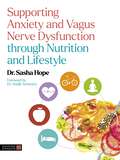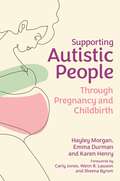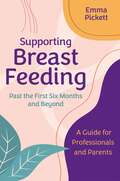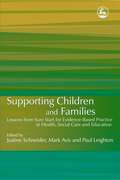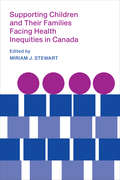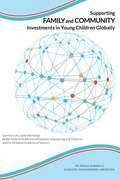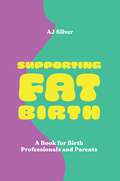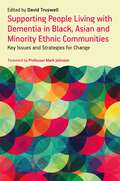- Table View
- List View
Supernatural
by Richard SmoleyThis gem-like, concise anthology provides thoughtful people with both an introduction to the paranormal and a reason to take a fresh look at it. Nostradamus. . . channeling. . . Atlantis. . . divination. Most serious people consider such topics nonsense. But look again. Writing with intellectual verve and a deeply critical mind, religious thinker Richard Smoley explores and reconsiders the supernatural in history and today. We are often conditioned to think of the Judeo-Christian tradition as the only valid, historically accurate, and rational spiritual philosophy. Occultism, magic, and the esoteric are, by contrast, considered illegitimate, delusional, and lacking in intrinsic worth. Supernatural challenges this prejudice, revealing that Western occult traditions are richer and more historically impactful than most of us imagine. The book reveals hidden diamonds and neglected ideas that characterize the magical tradition in the West. For any reader, at any level of experience, who has ever been curious about an arcane subject – from psychical powers to secret societies – here is a book that gives a complete yet precise, critical, yet serious, and always respectful account of topics from the unseen world. Supernatural is a brilliant primer to the occult and magical traditions of the West. Praise for RICHARD SMOLEY “I have a standing rule: I read anything Richard Smoley writes. ” —Larry Dossey, M. D. “Smoley . . . is adept at unknotting the paradoxes of spiritual traditions and making new connections across centuries and languages. ” —Library Journal “He is one of the liveliest, most intrepid, and most gifted explorers of the spiritual landscape writing today. ” —Ptolemy Tompkins, author of Paradise Fever .
Supernatural Lore of Ohio (American Heritage)
by Steven J. RolfesA rich vein of bizarre and uncanny tales snakes through Ohio's cornfields and cityscapes. In the earliest days of statehood, dark reports spoke of witches causing feathers to form a deadly ring in one's bed, magically strangling its sleeping victims. For years, the ghost of Abraham Lincoln's funeral train rolled through Urbana, a small town in the center of the state, and caused clocks and watches to stop in its wake. A vampiric entity was said to haunt a strange cabin in the Black Swamp, and a werewolf reportedly roamed a Defiance train yard. Join Cincinnati historian Steven J. Rolfes on a tour of Ohio's strangest supernatural lore, from wailing banshees to the devil himself.
Supernatural Lore of Southern Utah (American Legends)
by Darren M. EdwardsExplore humanity through what haunt us in Supernatural Lore of Southern Utah!From the fanciful and revelatory to the horrifying and sorrowful, the folklore of Southern Utah hints at a complex history. Whether spiritual or spooky, home-grown legends are a window to understanding local culture. Visit Grafton, Utah's most haunted ghost town. Explore what haunts Southern Utah University in Cedar City, the St. George Temple and Touquerville's "murder house." Learn about skinwalkers and the theft of Native American beliefs. Examine the numerous urban legends surrounding Route 666, "The Devil's Highway." Uncover the secrets of the Mountain Meadows Massacre and the curse of Escalante Petrified Forest. Drawing on information from over two hundred interviews, Darren M. Edwards investigates the tales and myths that permeate and persist in communities throughout red rock country.
Supernature: A Natural History of the Supernatural
by Lyall Watson'A fascinating feast of cosmic law and order...compelling reading' New ScientistIn this classic study of the supernatural, Lyall Watson challenges scientific orthodoxy by applying new criteria to the investigation of the unknown. Probing the 'soft edges' of science, Watson dispenses with the distinction between the natural and the supernatural and focuses on supernature; those phenomena that are not wholly paranormal, but which are not classified as natural occurrences according to traditional science. 'A book of tremendous importance' SpectatorWith both scientific objectivity and a wide-eyed sense of wonder at the mysteries of the universe, this fascinating and open-minded study proves beyond doubt that science is stranger than the supernatural.
Supernature: A Natural History of the Supernatural
by Lyall Watson'A fascinating feast of cosmic law and order...compelling reading' New ScientistIn this classic study of the supernatural, Lyall Watson challenges scientific orthodoxy by applying new criteria to the investigation of the unknown. Probing the 'soft edges' of science, Watson dispenses with the distinction between the natural and the supernatural and focuses on supernature; those phenomena that are not wholly paranormal, but which are not classified as natural occurrences according to traditional science. 'A book of tremendous importance' SpectatorWith both scientific objectivity and a wide-eyed sense of wonder at the mysteries of the universe, this fascinating and open-minded study proves beyond doubt that science is stranger than the supernatural.
Supernormal: Science, Yoga, And The Evidence For Extraordinary Psychic Abilities
by Dean RadinCan yoga and meditation unleash our inherent supernormal mental powers, such as telepathy, clairvoyance, and precognition? Is it really possible to perceive another person's thoughts and intentions? Influence objects with our minds? Envision future events? And is it possible that some of the superpowers described in ancient legends, science fiction, and comic books are actually real, and patiently waiting for us behind the scenes? Are we now poised for an evolutionary trigger to pull the switch and release our full potentials?Dean Radin, Director of Research at the Institute of Noetic Sciences (IONS) and bestselling author of The Conscious Universe, presents persuasive new experimental evidence for the existence of such phenomena. He takes us on a thrilling scientific journey and challenges outdated assumptions that these abilities are mere superstition. Focusing on Patanjali's mysterious Yoga Sutras -- 2,000 year-old meditation practices believed to release our extraordinary powers -- Radin offers powerful evidence confirming that sometimes fact is much stranger, spookier, and more wonderful than the wildest fiction.
Supernourishment for Children with Autism Spectrum Disorder: A Practical Nutritional Approach to Optimizing Diet for Whole Brain and Body Health
by Angelette MullerThis comprehensive guide provides everything you need to transition your child with autism to a nutrient-packed diet. It will increase your understanding of nutrition and autism by · explaining how diet supports the function of brain and body (including learning and attention, energy production, sensory processing and gut-brain communication) · describing how a highly processed diet can lead to nutritional deficiencies and how to choose more nutritionally dense options · looking at the science behind the challenges that children with autism face, such as problems with processing carbohydrates or ingredients such as phenols and oxalates. It then guides you through making dietary changes, offering · a range of breakfast, lunch, dinner, snacks and drinks recipes that are easy to follow and prepare. · coding to indicate which recipes can be used in conjunction with specialist diets including GF, CF, SCD, FODMAP and GAPS (so if your child is on a specific diet, this book is still for you) · practical tips on how to build a meal and plan a weekly menu · advice on overcoming common feeding challenges and poor eating habits. This book will be an invaluable addition to the shelves of parents of children with ASD as well as health practitioners such as nutritionists and dieticians who want to know more about autism.
Supernutrition
by Richard PasswaterMegavitamin therapy, good foods supplemented by vitamins to improve health and physical well-being. Chapters include Supernutrition Explained, Contraversies in Nutrition, Recent Discoveries in Nutrition, Vitamin C and the Common Cold, Megavitamin Therapy for Mental and Emotional Disorders, Cholesterol Doesnt Count, Expose of the Cholesterol Contraversy, Vitamin E and Heart Disease, Vitamin C with B Complex and Heart Disease, Hypoglycemia and the Dangers of Sugar, Cancer and Vitamin Therapy, Supernutrition and Staying Younger Longer, and an Appendix- Vitamin Guidewith Supernutrition Curves. The book is written in a style understandable to the average reader.
Superpower Dogs
by CosmicMeet the real-life superheroes who walk--and bark--among us in this stunning photographic picture book featuring the stars of the IMAX film Superpower Dogs! Every single day, dogs around the world use their amazing abilities to help save lives. In over fifty dynamic photos and a fun, fact-filled text, meet some of the incredible canines who save lives, fight crime, and help people heal. Superpower Dogs is a fun and inspiring read for animal lovers of all ages, celebrating the remarkable work of heroic dogs.
Superpower Dogs: Avalanche Rescue Dog
by CosmicJoin Henry, one of the stars of the IMAX film Superpower Dogs, as he emBARKS on a journey to become an avalanche rescue dog in this gripping true story, perfect for fans of Max! In Whistler, British Columbia, dogs can be found riding chairlifts, perched on skiers' shoulders, and even descending from helicopters--all in the race against time to save people caught in the path of an avalanche. Meet Henry, a lovable border collie, and the team of dogs and human partners he works with in the beautiful and sometimes dangerous mountains. Through the action-packed narrative, informative and engaging interstitials, and eight pages of stunning full-color photographs, young readers will experience real-life rescues and gain a new appreciation for the bond between dogs and humans.
Superpower Dogs: Disaster Response Dog
by CosmicJoin Halo, one of the stars of the IMAX film Superpower Dogs, as she emBARKS on a journey to become a disaster response dog in this gripping nonfiction story, perfect for fans of Max! Dutch Shepherd puppy Halo has spent almost her whole life preparing for one job: finding people who are trapped in disaster zones. Her bond with her human partner, Fire Captain Cat, is unshakeable, and together, they can overcome any obstacle. But training to be an Urban Search and Rescue dog is tough, and it's going to take all of Cat's dedication and Halo's courage to succeed. Enhanced with breathtaking photographs and amazing canine facts, this true story of a hero's journey from adorable puppy to skilled Urban Search and Rescue dog is proof that real life superheroes walk--and bark--among us.
Superpowered: Transform Anxiety into Courage, Confidence, and Resilience
by Dr Shefali Tsabary Renee JainThe perfect tool for children facing new social and emotional challenges in an increasingly disconnected world! This how-to book from two psychology experts--packed with fun graphics and quizzes--will help kids transform stress, worry, and anxiety. Give it to fans of The Confidence Code for Girls and Raina Telgemeier's Guts. <P><P>Now more than ever, kids need to feel empowered as they work through anxiety, overwhelm, and uncertainty brought on by the world around them. With its helpful, hands-on suggestions and tips, SUPERPOWERED will be embraced by every kid with insecurities, worries, and anxious thoughts. <P><P>Renee Jain (founder of GoZen!) and Dr. Shefali Tsabary (New York Times bestelling author and Oprah contributor) make readers the superheroes of their own stories. They introduce a toolkit of easy-to-understand methods for recognizing anxious behaviors, identifying the root causes of worried thinking, and realizing that strength can be found in reclaiming one's inner superpowers. <P><P>With the help of humorous artwork and interactive elements, readers find their P.O.W.E.R. (an acronym that inspires mindfulness and resilience practices) and gain lasting mental strength. <P><P><b>A New York Times Bestseller</b>
Supersentidos de supervivencia (¡Arriba la Lectura! Level T #80)
by Sharon ParsonsNIMAC-sourced textbook <p><p> A través de los sentidos comprendemos lo que ocurre en el mundo que nos rodea. La mayoría de nosotros usamos la vista, el oído, el tacto, el gusto y el olfato para conocer nuestro entorno, sin darnos cuenta de que cada uno de estos sentidos nos está ayudando a mantenernos fuera de peligro. Lee cómo nosotros y otros seres vivos usamos los sentidos para sobrevivir. ¡Aprenderás un montón de datos supersensoriales!
Supertwins and Tooth Trouble
by B. J. JamesSomeone is stealing the teeth underneath children's pillows! Who could it be? It's the Terrible Tooth Snatcher. He has captured the Tooth Fairy and is attempting to take over the world. The Supertwins to the rescue.
Supervida
by Darin OlienUm revolucionário guia de saúde e bem-estar que nos ensina a maximizar o potencial inato do nosso corpo para se regenerar, energizare curar, focando-nos em cinco forças vitais: Nutrição, Hidratação, Oxigenação, Alcalinização e Desintoxicação. Um convite para um novo estilo de vida! Da autoria do coanfitrião da série documental da NETFLIX Down to Earth. Todos sabemos o que significa viver bem: seguir uma alimentação saudável, fazer exercício físico, meditar e adicionar uma boa quantidade de espinafres aum batido. Mas será isto suficiente? Supervida é um revolucionário guia de saúde e bem-estar que nos ensina a maximizar o potencialinato do nosso corpo para se regenerar, energizar e curar, focando-nos em cinco forças vitais: Nutrição: alimentos integrais, frescos, não processados; Hidratação: qualidade e quantidade de água; Oxigenação respiração profunda e consciente; Alcalinização: equilíbrio entre acidez e alcalinidade no organismo; Desintoxicação: eliminação de substâncias nocivas. Pondo em prática o resultado das suas pesquisas, Darin Olien explica-nos como obter um peso saudável, prevenir doenças e aproveitar os superpoderes da alimentação,da água, do oxigénio e de um pH equilibrado para viver melhor, sem dietas restritivas e complexas. Um guia revolucionário sobre 5 forças vitais que o farão sentir-se saudável e em forma. «O Darin tem uma verdadeira paixão por saúde e nutrição, e prova-o com este guia acessível para alcançar a melhor vida possível.» — Laird Hamilton, surfista e autor bestseller do New York Times.
Supper with Love: Vibrant, Delicious, and Comforting Plant-Forward and Pescatarian Recipes for Every Day
by Michelle BraxtonBeloved Southern Instagrammer and food blogger Michelle Braxton’s long awaited debut cookbook is filled with delectable comfort food recipes that are plant-forward and pescatarian, easy-to-prepare and flexible, made with wholesome and seasonal ingredients, all shared in her signature warm and welcoming style.Michelle Braxton has always believed that the secret ingredient to any dish is love, and that the best part of any meal is the joy that comes with sharing food with the people you care about. She founded her blog Supper with Michelle as a way to celebrate vegetables and spread the joy and happiness she finds in plant-forward and pescatarian cooking. With over 85 recipes, Michelle shows just how simple, nourishing, and flavorful plant-forward meals can be.In Supper with Love, Michelle shares her very personal journey of food, love, and life. With some of her favorite beautifully photographed recipes for vibrant and satisfying salads, soups, side dishes, sandwiches, bowls, brinners, and suppers, highlighting natural and in-season ingredients every step of the way. Bringing meatless twists to some classic comfort dishes, she crafts approachable, easy-to-prepare meals that are nourishing and crave-worthy. And as a firm believer in finding the food lifestyle that works best for you, she encourages readers to get into your groove and “freestyle it" by offering countless variations and substitutions for ingredients, ways to “veganize” recipes (if they aren’t already vegan), recipe pairings, and creative ways to repurpose leftovers, so you can enjoy her recipes any way you want. From simple one-pot meals to Sunday suppers, there are recipes for every taste, mood, and schedule.Though her passion for food was nurtured by her upbringing and childhood in Georgia, Michelle now finds inspiration in cuisines from all over the world. Readers will be inspired with innovative salads like the Strawberry & Halloumi Salad with Creamy Balsamic Dressing and Zesty Ranch Broccoli-Pasta Salad, crowd-pleasing sides like Loaded Smashed Potatoes and Baked Tomato Rice with Castelvetrano Olives, and because Michelle has been coined as the “soup queen”—wholesome soups like Sunshine Dal and blog favorite… Vegetarian Zuppa Toscana, and hearty entrees like the Sunday Night Vegetable Pot Pie and Kitchen Sink Enchilada Casserole.Supper with Love makes eating your veggies fun, nutritious, and delicious. Whether you’re a vegetarian or an omnivore, a savvy home chef or a total beginner, or looking to feed one hungry mouth or a whole table’s worth, these recipes will not only satisfy, but feed your body and soul. So, pull up a chair, because you’re invited for supper!
Supplements Exposed: The Truth They Don't Want You to Know About Vitamins, Minerals, and Their Effects on Your Health
by Brian R. ClementWhat if just about everything you thought you knew about supplements and health turned out to be absolutely wrong? In this book, nutrition expert Dr. Brian Clement, director of the world-famous Hippocrates Health Institute, explores the various myths that have made supplements a buyer-beware industry. Supplements Exposed strips away layers of deception to reveal the truth about what millions of supplement users each year have taken for granted. Nearly all supplements sold in the United States and the world are synthetics created in pharmaceutical industry labs. As a result, they can be toxic to your health. There are distinct differences between natural (plant-derived) supplements and synthetic (chemically-derived) supplements and how they each impact your health. Nearly all medical science studies of nutrients and human health have used synthetics rather than natural nutrients, which throws the accuracy of all negative laboratory results into serious doubt. This provocative book guides you through the minefield of choices you face every time you buy vitamins and minerals. It shows you how to decipher product labels that are otherwise deceptive, how to choose naturally occurring (plant-derived) supplements, why recommended daily allowances spread confusion, and much more.
Supporting Anxiety and Vagus Nerve Dysfunction through Nutrition and Lifestyle
by Sasha HopeThe vagus nerve is responsible for the regulation of all our internal organ functions. When it is damaged, the wide-ranging impact on our nervous system can manifest in a multitude of ways, including anxiety, hormonal imbalances, gastrointestinal distress, and vertigo.Based on current research into the vagus nerve and vagus nerve stimulation, this practical guide addresses a crucial missing link in healthcare and functional medicine by providing an innovative protocol on the management of anxiety and vagus nerve dysfunction through nutrition, exercise, and lifestyle. With a holistic, whole-person approach, this protocol bridges the divide between the physical and the psychological, providing a holistic approach that can be applied widely across various disciplines within healthcare, bodywork, and mental health. It provides detailed theory and is supplemented with an abundance of practical guidance including various recipes whilst also helping practitioners understand how clients may transition to a more sustainable, long-term protocol.
Supporting Autistic People Through Pregnancy and Childbirth
by Hayley Morgan Emma Durman Karen HenryThis comprehensive and accessible guide is for every birthing and health professional looking to improve their care during pregnancy, birth, and aftercare for autistic women. With a distinct lack of scientifically approached work in this area, this much-needed book takes an intersectional, feminist approach and covers the background of modern birth practices and autism as a diagnosis.With intersectionality as a core feature, the impact of cultural differences, underdiagnoses, stigma, and stereotypes amongst ethnic minorities is also included. It discusses how pain functions in the autistic brain as well as co-occurring conditions such as alexithymia, chronic pain, epilepsy, and Ehlers-Danlos Syndrome.This multidisciplinary author team includes two well-established autism experts, and an experienced midwife and lecturer who provides invaluable birthing insight, as well as approaches for sensation management during birth, insider knowledge on midwifery protocols, and accessible tools for autistic pregnant people and families to use.
Supporting Breastfeeding Past the First Six Months and Beyond: A Guide for Professionals and Parents
by Emma PickettThis evidence-based guide for professionals covers essential information to help support parents breastfeeding past the first six months, including starting solids alongside breastfeeding, nursing manners, and common problems and challenges.The recommendation of breastfeeding beyond six months is well-established, but many birth professionals don't feel confident enough to support parents. This book, packed with case studies of real-life parents and practical tips, helps to educate healthcare professionals - as well as parents themselves - to feel better informed. Each chapter combines professional, research-led evidence with a parent-focused resource section for a fully integrative approach.Centring families and their personal journeys, Supporting Breastfeeding Past the First Six Months and Beyond is an invaluable guide for all lactation consultants, birthing professionals, healthcare workers and parents.
Supporting Children and Families: Lessons from Sure Start for Evidence-Based Practice in Health, Social Care and Education
by Pamela Graham Ann Martin John Carpenter Paul Leighton Alison Edgley Matthew Pearson Sharon Hodgson Geoff Lindsay Lynn Mckenna Alissa Goodman Miranda Thurston Graham Bowpitt Jill Jesson Martin Manby Marjorie Finnigan Pauline Hall Valerie Wigfall Nicky Nicholls Susan Mcquail Sarah Chaudhary Mark Avis Barbara Sianesi Justine Schneider Mairi Ann Cullen Brid FeatherstoneSupporting Children and Families gathers together the lessons learned from perhaps the largest scale social experiment ever undertaken in England - Sure Start, the programme designed to improve the emotional development, health and education of children. It boils down the huge amount of knowledge and experience generated by the Sure Start programmes and local evaluation studies, with chapters encompassing child development and healthcare, partnership working with existing local services, parental employment and supporting families with young children, reaching out to marginalised groups and strengthening communities. In addition to summarizing the findings of numerous innovative projects, contributors draw on their experiences of the successes and challenges to offer advice for those engaged in current and future practice. Each chapter concludes with `three lessons for Children's Centres'. With its strong focus on practice implications, this book is indispensable reading for practitioners working in health, social and educational services for children and families, as well as students or researchers, and policymakers in these fields.
Supporting Children and Their Families Facing Health Inequities in Canada
by Miriam J. StewartSupporting Children and Their Families Facing Health Inequities in Canada fills an urgent national need to analyze disparities among vulnerable populations, where socio-economic and cultural factors compromise health and create barriers. Offering solutions and strategies to the prevalent health inequities faced by children, youth, and families in Canada, this book investigates timely issues of social, economic, and cultural significance. Chapters cover a diverse range of socio-economic and cultural factors that contribute to health inequality among the country’s most vulnerable youth populations, including mental health challenges, low income, and refugee status. This book shares scientific evidence from thousands of interviews, questionnaires, surveys, and client consultations, while also providing professional insights that offer key information for at-risk families experiencing health inequities. Timely and transformative, this book will serve as an informed and compassionate guide to promote the health and resiliency of vulnerable children, youth, and families across Canada.
Supporting Family and Community Investments in Young Children Globally: Summary of a Joint Workshop by the National Academies of Sciences, Engineering, and Medicine and the Ethiopian Academy of Sciences
by Engineering Medicine National Academies of SciencesTo examine the science, policy, and practice surrounding supporting family and community investments in young children globally and children in acute disruptions, the National Academies of Sciences, Engineering, and Medicine held a workshop in partnership with the Ethiopian Academy of Sciences in Addis Ababa, Ethiopia, from July 27-29, 2015. The workshop examined topics related to supporting family and community investments in young children globally. Examples of types of investments included financial and human capital. Participants also discussed how systems can better support children, families, and communities through acute disruptions such as the Ebola outbreak. Over the course of the 3-day workshop, researchers, policy makers, program practitioners, funders, young influencers, and other experts from 19 countries discussed how best to support family and community investments across areas of health, education, nutrition, social protection, and other service domains. This report summarizes the presentations and discussions from the workshop.
Supporting Fat Birth: A Book for Birth Professionals and Parents
by AJ SilverThis pioneering guide provides birth professionals, pregnant people, and advocates with comprehensive insight into navigating conception, pregnancy, birth, and the perinatal period whilst fat. Drawing on the author's decade of experience as well as evidence-based research and case studies from people sharing their own perspectives and stories, this authoritative and compassionate book provides practical and effective advice on how to improve quality of care for fat parents. It covers a wide range of topics across the birth journey and beyond including interviews with a number of high-profile people including Nicola Salmon and Amber Marshall and empowers readers to feel reassured and confident in their choices and rights. This ground-breaking resource challenges the pervasive bias against fat service users in the birthing world and acts as a call to action to dismantle the fatphobic stigma present in our healthcare systems in order to create an environment that is inclusive of all bodies.
Supporting People Living with Dementia in Black, Asian and Minority Ethnic Communities: Key Issues and Strategies for Change
by Natalie Tobert Toby Williamson Dr Mary Tilki Dr Karan Jutlla Harjinder Kaur Tom Lam Gill Tan Padraic Garrett Dr Shibley RahmanFocusing on individual Black, Asian and Minority Ethnic (BAME) communities such as Irish, Caribbean, South Asian, Chinese and Jewish, this accessible guide brings together key information on the impact of living with dementia in BAME communities into a single comprehensive resource for front-line staff as well as an information source for families and carers. The book sets out personal case studies and examines how to provide bespoke support and information to raise awareness and lower levels of stigma. With diagnoses among minority communities set to increase, this much-needed handbook is the perfect companion for care home workers, social workers, doctors and nurses who may lack experience in communicating with and caring for people from BAME backgrounds. It is also a valuable resource for family carers and those living with dementia.
